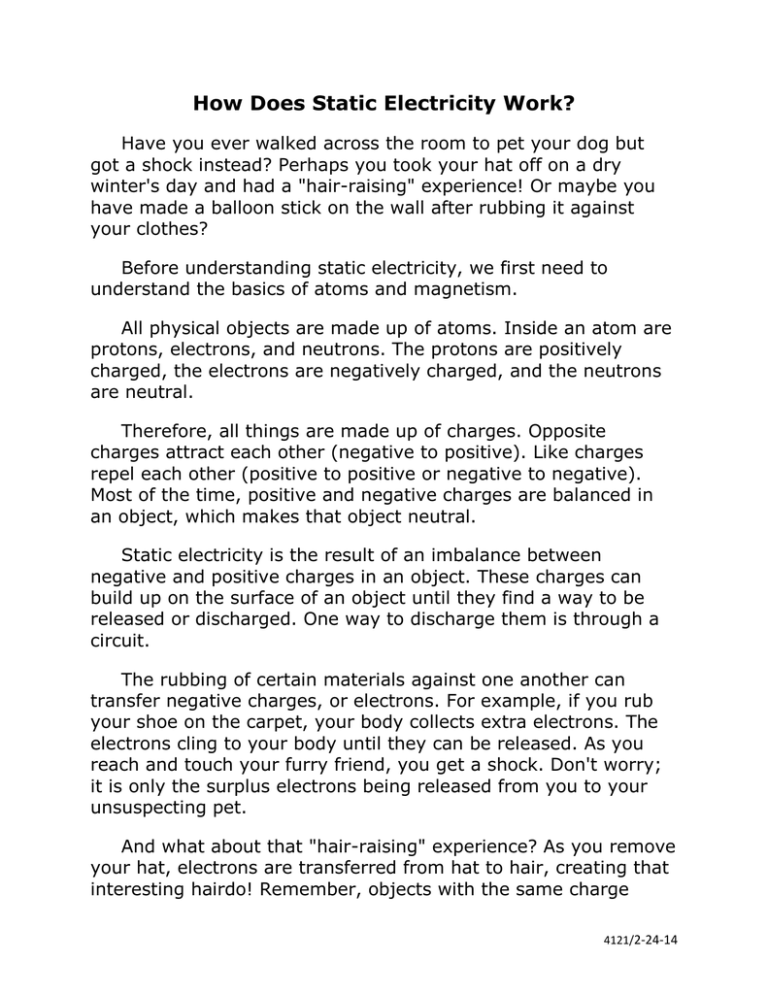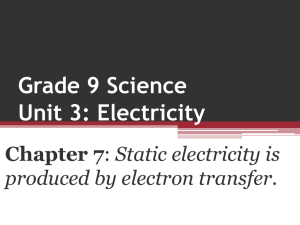How Does Static Electricity Work?
advertisement

How Does Static Electricity Work? Have you ever walked across the room to pet your dog but got a shock instead? Perhaps you took your hat off on a dry winter's day and had a "hair-raising" experience! Or maybe you have made a balloon stick on the wall after rubbing it against your clothes? Before understanding static electricity, we first need to understand the basics of atoms and magnetism. All physical objects are made up of atoms. Inside an atom are protons, electrons, and neutrons. The protons are positively charged, the electrons are negatively charged, and the neutrons are neutral. Therefore, all things are made up of charges. Opposite charges attract each other (negative to positive). Like charges repel each other (positive to positive or negative to negative). Most of the time, positive and negative charges are balanced in an object, which makes that object neutral. Static electricity is the result of an imbalance between negative and positive charges in an object. These charges can build up on the surface of an object until they find a way to be released or discharged. One way to discharge them is through a circuit. The rubbing of certain materials against one another can transfer negative charges, or electrons. For example, if you rub your shoe on the carpet, your body collects extra electrons. The electrons cling to your body until they can be released. As you reach and touch your furry friend, you get a shock. Don't worry; it is only the surplus electrons being released from you to your unsuspecting pet. And what about that "hair-raising" experience? As you remove your hat, electrons are transferred from hat to hair, creating that interesting hairdo! Remember, objects with the same charge 4121/2-24-14 repel each other. Because they have the same charge, your hair will stand on end. Your hairs are simply trying to get as far away from each other as possible! When you rub a balloon against your clothes, and it sticks to the wall, you are adding a surplus of electrons (negative charges) to the surface of the balloon. The wall is now more positively charged than the balloon. As the two come in contact, the balloon will stick because of the rule that opposites attract (positive to negative). Static Electricity Try This Experiment . . . Rub a balloon filled with air on a wool sweater or on your hair. Then hold it up to a wall. The balloon will stay there by itself. Tie strings to the ends of two balloons. Now rub the two balloons together, hold them by strings at the end and put them next to each other. They'll move apart. Rubbing the balloons gives them static electricity. When you rub the balloon it picks up extra electrons from the sweater or your hair and becomes slightly negatively charged. The negative charges in the single balloon are attracted to the positive charges in the wall. The two balloons hanging by strings both have negative charges. Negative charges always repel negative charges and positive always repels positive charges. So, the two balloons' negative charges "push" each other apart. Static electricity can also give you a shock. If you walk across a carpet, shuffling your feet and touching something made of metal, a spark can jump between you and the metal object. Shuffling your feet picks up additional electrons spread over your body. When you touch a metal doorknob or something with a 4121/2-24-14 positive charge, the electricity jumps across the small gap from your fingers just before you touch the metal knob. If you walk across a carpet and touch a computer case, you can damage the computer. One other type of static electricity is very spectacular. It's the lightning in a thunder and lightning storm. Clouds become negatively charged as ice crystals inside the clouds rub up against each other. Meanwhile, on the ground, the positive charge increases. The clouds get so highly charged that the electrons jump from the ground to the cloud, or from one cloud to another cloud. This causes a huge spark of static electricity in the sky that we call lightning. END OF TEXT "How Does Static Electricity Work?" In the public domain. "Static Electricity." In the public domain. 4121/2-24-14






